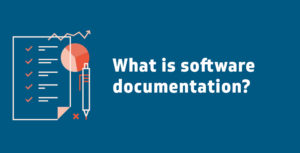Share user knowledge internally and externally
The world around us is becoming increasingly complex, digital and fast. The range of things we are dealing with is getting wider and wider. This is why there are more and more experts who have a lot of specialized knowledge in their fields.
The key challenge in this world is the successful transfer of information between experts and those who need the information. Such an exchange requires an organized structure: a database in which information can be 1. stored and 2. retrieved in an orderly fashion.
Especially with regard to digital structures and IT problems, communication otherwise quickly ends in chaos. Did you know that studies show that the IT department in companies spends 30% of its time answering support requests from employees or customers? This is inefficient and costs time, money and creates stress. At the same time, good customer support significantly increases the overall quality of your business.
That’s why companies, whether small, medium or large, always need an orderly channel through which information is transmitted. In this article we will show you how to organize your information exchange in databases or a helpdesk.
What is a helpdesk or a database?
Both, knowledge databases and helpdesks, store special knowledge in a structured way and make it accessible for users. At the same time, users can submit new requests for help and ask for solutions.
There are two main target groups for these databases:
- Knowledge databases (or knowledge bases) for internal user in the company
- Helpdesks for support requests from external users, for example customers
What do I need this for?
1. Efficiency
Helpdesks and knowledge bases can significantly increase efficiency in companies. Problems are solved faster and more cost-effectively: Through the organized channel instead of countless phone calls, e-mails or portal messages. In addition, a constant repetition of the same calls is eliminated.
A good helpdesk makes an enormous difference in the number of calls made. One example is Deutsche Bahn. With the establishment of a new helpdesk, the so-called “Unified Enterprise Mobility Management”, Deutsche Bahn has reduced the monthly number of calls from mobile device users from 2100 to 210. The costs of this support offer were thus reduced by 75%.
2. External: Increased quality
A helpdesk is an elementary part of your customer relationship management (CRM). It makes you as a company accessible to your customers, makes you a contact person and problem solver. This generates a high level of satisfaction, increases the perceived quality of your offer and binds customers to the company in the long term.
Studies show that almost all customers accept good knowledge databases: 91% of all respondents say they want to use a knowledge database if it meets their needs. 67% even prefer the self-service option to talking to a customer service representative.
3.Internal: Standardized processes and resource gains
A knowledge database supports internal processes within the company: It relieves much consulted experts, such as the IT department. The IT experts can answer support queries in a compressed form via the knowledge database. This saves time and resources that can be used for more strategic tasks.
4. Internal: Knowledge Backup
In studies 38% of firm respondents stated that much or even all information would be lost if they left the company immediately. That demonstrates that knowledge of employees leaving the firm is often not well or insufficiently secured. With a structured, high-quality knowledge database, knowledge remains available to the company even when employees leave the firm. New colleagues can acquire know-how independently using the available material.
5. Organisation
In a database or a helpdesk, important information is centralized and accessible for everyone. This way, all employees in the company are actively involved: they can help themselves more easily and are more independent of experts. This is of immense value and promotes interaction, innovation and initiative.
How do I set it up?
The development of a knowledge database is mainly divided into three steps:
- Analysis: Collect data
- Select a tool provider
- Create tickets
1. Collect Data
Define goals: Which requirements should the helpdesk meet? Which areas should it cover and which features should it have (tickets, live chat, forum…)?
Define target group: For whom is the support intended? What knowledge does the group have and through what channels does it seek support?
Analysis: Where are the problems, what kind of questions do users have? Which problems are particularly common? What are their causes? Which processes do users perform particularly frequently? Which requests have been recently submitted by customers or employees?
Then you create a list of the most important tickets to be created and divide them into meaningful areas.
It is possible, for example, to divide the list into sections:
- Time of the need for support (first steps, start, in-depth use)
- Software (in the company: Questions about different applications in different categories)
- Different use cases
- Customer groups
- Prices, application, administration, troubleshooting
Of course, you must define individually for yourself which structure makes sense for you and your company, taking into account your target group and work area.
2. Select a tool provider
Of course, you can also create your own website to provide customer or employee support. However, the use of specialized help desk software has proven to be a good solution. This software helps to track, prioritize and resolve support requests (so-called tickets) from customers through its provided structures.
When building a good support system, the choice of a good tool is fundamental. There are numerous providers on the market that offer a wide range of features for varying prices. Many providers also provide a basic version of their software free of charge. In many cases it is worth testing this before buying the extended version of the software: This way you can check in advance if the product meets your requirements.
Possible features according to which you can select the software according to your needs:
- Adaptable to your requirements?
- Live chat possible?
- Integration of your existing channels (Facebook/ Twitter/ etc.) possible?
- Compatibility with your software?
- Ease of use and intuitive operation?
- Customer surveys possible?
- Including a user forum?
- Task management possibilities?
- Analysis tools (statistics, usage reports)?
- Price?
When making your selection, you should always keep in mind the future users of the support on the one hand and the support desk agents who will operate the support desk on the other.
Some of the largest providers on the market are:
- Market leader: ZenDesk (more than 100.000 customers)
- Manage Engine
- Freshdesk
- ClickDesk
- Jira Service Desk
… but there are many others.
You can find current comparisons of the best helpdesk software providers on the Internet and in trade magazines, where you can search for the best solution for your needs, individually adapted to your requirements.
3. Create tickets
Then it’s time to get down to business: creating your tickets and uploading them to your database.
There are a few things you should keep in mind – Checklist for your tickets:
- As short as possible, as long as necessary?
- Question words (Who, Where, How, When, Why) answered?
- Clear structure? (enumeration, numbering or step by step explanations)
- Clarity: paragraphs added and important things highlighted?
- All technical terms and abbreviations explained?
- No prior knowledge required?
- Read and understood by external users (test users)?
- Supported with pictures/screenshots/graphics but not overloaded?
- Linked to further tickets?
In addition to the tickets that you create in advance, you should also make one or more employees responsible for processing incoming tickets. They will answer further user questions that go beyond the available information in the database and thus constantly expand your support service.
Which mistakes should I avoid?
When creating a helpdesk or a knowledge base there are a few mistakes that you should definitely avoid:
- Outdated content
Nothing is worse than a support description that doesn’t help me because it is outdated – due to updates, new developments or something else. That’s why it’s essential that you manage your help center at least occasionally after it has been set up and update it whenever changes occur. - Unclear content
The second big faux pas: I, as a user, visit your helpdesk, find exactly the topic I need – but do not understand the content because it is not well described. This frustrates and creates dissatisfaction, which is projected onto your company. That’s why you should keep your tickets as simple as possible, start at the very bottom of the basics and take all users with you! If I as a user can skip something because I already know it, that’s not so bad. But if I miss something important, the whole helpdesk becomes useless for me. - Unclear structures and categories
The best content in your database is of no use to your users if it cannot be found. That’s why you should give your categories and tickets meaningful names and create a clear, concise structure. - Promises that are not kept
When users submit tickets, they expect a response from a support center. Delayed orders and lost tickets make users feel that they have been let down. In the IT Excellence Benchmark (ITEB), 22% of respondents said they were not kept up to date while their problems were being resolved – avoid this, be available and answer urgent tickets if you consider this part of your service.
Additional tips
What else can you do?
- Give your users the choice: Offer your answer in several formats. Then your users can choose, for example, between text instructions, a video link and pdf instructions for download.
- Don’t forget internal acceptance: Measure the use of and satisfaction with your helpdesk to create the basis for your work internally as well. Concrete figures prove the indispensability of your support efforts.
- Optimize also in the mobile view. Today mobile is no longer an option, but a necessity that should not be ignored.
- Don’t leave your helpdesk alone even after the installation! Analyze its use, which tickets are requested, which terms are searched for, where comments are made and where improvements may be necessary. Because: Feedback is a gift! Accept it and optimize your structures.
- Let users join the game: Forums and user-help-user facilities can take a lot of work off your shoulders – and sometimes other users can explain solutions much better than the experts might be able to.
- Last but not least: Pay attention to quality. Especially in support, quality prevails over quantity. In times of the internet, we are drowning in information but lack really relevant knowledge. Better do less, but do it well!
For us, as developers of documentation software, the topic of information management is indispensable. We are glad that FlowShare has already helped many companies successfully to share information efficiently within the company and to build up knowledge databases. You can read an example case here.
We hope you enjoy implementing our tips and wish you success in developing your own knowledge base!







